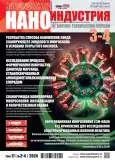Сканирующая капиллярная микроскопия. Визуализация и количественная оценка
- Авторы: Ахметова А.И.1,2, Яминский И.В.1,2
-
Учреждения:
- МГУ имени М.В.Ломоносова, физический факультет
- ООО НПП "Центр перспективных технологий"
- Выпуск: Том 17, № 3-4 (2024)
- Страницы: 184-189
- Раздел: Оборудование для наноиндустрии
- URL: https://journals.eco-vector.com/1993-8578/article/view/633079
- DOI: https://doi.org/10.22184/1993-8578.2024.17.3-4.184.189
- ID: 633079
Цитировать
Полный текст
Аннотация
Исследование морфологии объектов и их механических характеристик позволяет обнаруживать уникальные свойства клеток и связывать эти особенности с развитием в норме или при наличии патологий. Для измерения поверхности образца в сканирующей капиллярной микроскопии (СКМ) в качестве зонда используется заполненный электролитом капилляр с наноразмерным отверстием на кончике. Главным преимуществом СКМ является бесконтактная визуализация топографии биологических объектов в естественной среде – сканирование осуществляется без силового контакта кончика зонда с поверхностью образца. Дополнительно СКМ можно использовать для определения электрических зарядов на границе раздела твердое тело и жидкость. В этой статье мы описываем основы СКМ, возможности метода для визуализации клеток и измерения биомеханических свойств живых образцов.
Ключевые слова
Полный текст
Об авторах
А. И. Ахметова
МГУ имени М.В.Ломоносова, физический факультет; ООО НПП "Центр перспективных технологий"
Email: yaminsky@nanoscopy.ru
ORCID iD: 0000-0002-5115-8030
кандидат физико-математических наук, ведущий специалист
Россия, Москва; МоскваИ. В. Яминский
МГУ имени М.В.Ломоносова, физический факультет; ООО НПП "Центр перспективных технологий"
Автор, ответственный за переписку.
Email: yaminsky@nanoscopy.ru
ORCID iD: 0000-0001-8731-3947
доктор физико-математических наук, профессор, ген. директор
Россия, Москва; МоскваСписок литературы
- Akhmetova A.I., Sovetnikov T.O. et al. The heart of the capillary microscope. NANOINDUSTRY, 2023. Vol. 16. No. 7–8. PP. 444–448. https://doi.org/10.22184/1993-8578.2023.16.7-8.444.448
- Monzel C., Sengupta K. Measuring shape fluctuations in biological membranes. J. Phys. D: Appl. Phys., 49. 2016. Article 243002, https://doi.org/10.1088/0022-3727/49/24/243002
- Pellegrino M., Orsini P., Tognoni E. Membrane fluctuations of human red blood cells investigated by the current signal noise in scanning ion conductance microscopy, Micron, 2024. Vol. 181. P. 103635. https://doi.org/10.1016/j.micron.2024.103635
- Seifert J., Rheinlaender J. et al. Thrombin-induced cytoskeleton dynamics in spread human platelets observed with fast scanning ion conductance microscopy. Nat. Sci Rep. 2017. Vol. 7. No. 1. P. 4810. https://doi.org/10.1038/s41598-017-04999-6
- Nikolaev N.I., Müller T. et al. Changes in the stiffness of human mesenchymal stem cells with the progress of cell death as measured by atomic force microscopy. J. Biomech. 2014. Vol. 47. PP. 625–630. https://doi.org/10.1016/j.jbiomech.2013.12.004
- Su X., Zhou H. et al. Nanomorphological and mechanical reconstruction of mesenchymal stem cells during early apoptosis detected by atomic force microscopy. Biol. Open. 2020. Vol. 9. https://doi.org/10.1242/bio.048108
- Meng H., Chowdhury T.T., Gavara N. The Mechanical interplay between differentiating mesenchymal stem cells and gelatin-based substrates measured by atomic force microscopy. Front. Cell Dev. Biol., 2021. Vol. 9. https://doi.org/DOI 10.3389/fcell.2021.697525
- Docheva D., Padula D. et al. Researching into the cellular shape, volume and elasticity of mesenchymal stem cells, osteoblasts and osteosarcoma cells by atomic force microscopy. J. Cell. Mol. Med., 2008. Vol. 12. PP. 537–552. https://doi.org/10.1111/j.1582-4934.2007.00138.xopen_in_new
- Nozawa K., Zhang X. et al. Topographical evaluation of human mesenchymal stem cells during osteogenic differentiation using scanning ion conductance microscopy, Electrochimica Acta. 2023. Vol. 449. P. 142192. https://doi.org/10.1016/j.electacta.2023.142192
- Muhammed Y., Lazenby R.A. Scanning ion conductance microscopy revealed cisplatin-induced morphological changes related to apoptosis in single adenocarcinoma cells. Anal Methods. 2024. Vol. 16. No. 4. PP. 503–514. https://doi.org/DOI 10.1039/d3ay01827j
- Wang D., Woodcock E. et al. Exploration of individual colorectal cancer cell responses to H2O2 eustress using hopping probe scanning ion conductance microscopy, Science Bulletin. 2024. https://doi.org/10.1016/j.scib.2024.04.004
- Honda K., Yoshida K. et al. In situ visualization of LbL-assembled film nanoscale morphology using scanning ion conductance microscopy, Electrochimica Acta. 2023. Vol. 469. P. 143152. https://doi.org/10.1016/j.electacta.2023.143152
- Akhmetova A.I., Sovetnikov T.O. et al. Scanning capillary microscopy in the study of the effect of cytotoxic agents on the biomechanical and physicochemical properties of tumor cells. Pharmaceutical Chemistry Journal. 2022. https://doi.org/10.1007/s11094-022-02770-4
- Sovetnikov T.O., Akhmetova A.I. et al. Scanning probe microscopy in assessing blood cells roughness. Bio-Medical Engineering. 2023. https://doi.org/10.1007/s10527-023-10253-3
- Actis P., Tokar S. et al. Electrochemical nanoprobes for single-cell analysis. ACS Nano. 2014. Vol. 8. No. 1. PP. 875–884. https://doi.org/10.1021/nn405612q
- Sovetnikov T.O., Akhmetova A.I. et al. Characteristics of the use of scanning capillary microscopy in biomedical research. Bio-Medical Engineering. 2023. Vol. 57. No. 4. PP. 250–253. https://doi.org/10.1007/s10527-023-10309-4
Дополнительные файлы







